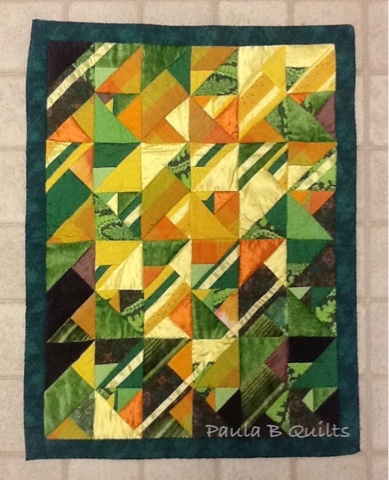FIRELIGHT: I was inspired to make this first wall hanging to use a piece of tie dyed fabric in warm shades. I made it back in the late 60's when the kids were little. Two other friends would show up, all of us with toddlers, and turn the back yard into an art studio for tie dye, batik, silk screening or whatever.
The warm colors in the piece developed into the idea of a campfire at night. I learned so much about color, using purples, teal, but no black or dull tones for the darkness.
The piece I began with is the slanting one in the center, with pinks and yellows. I added small bits of satin for the sheen, plaids and dark purple velvet. It does convey the image of sparks flying up into the darkness.
MOONLIGHT: How do you convey moonlight? By its reflection on water, snow, etc. This is how I interpreted a snow scene at night, with shiny and sparkling fabrics in contrast to the deep purples and blues. I never used black or grey in these quilts. Even shadows are seen as color. There is a small bit of white satin to represent the moon.
SUNLIGHT: This was a challenge to convey sunlight streaming down through the forest. I tested and eliminated any greyed colors, using only true hues. For the leaves I found an pieces from an old 1960's silk sheath dress for $1. Again I used Thai silk, velvets and added yellow ribbons for the rays of the sun. Purple was used in the shadows because it is the complement of yellow.
I learned a great deal about color by doing these wall hangings and they are one of my favorite series. It helped me to have the block structure to work within so that nothing was random, but chosen for its particular shape and placement.
I'm very happy to be linking up with Ad Hoc Improv Quilter at Fret Not Yourself. Please check out the fascinating things shared there.






Purple makes better shadows and darkness than black. It certainly adds more depth to the scene. Your quilts demonstrate this so well, Paula. I can see the story of each. Isn't it great when our older work "wears well" through the years?
ReplyDeleteThanks for linking with AHIQ.
Wonderful interpretation Paula, you've captured the moods beautifully.
ReplyDeleteLovely series!
ReplyDeleteWow, with just these few pictures, I learned so much about light and shadow and using complimentary colors instead of blacks. Thanks! I was thinking a bit about improv quilts today and then while walking through a bookstore, I saw a jigsaw puzzle with a painting by Paul Klee and thought, ooh that would be a neat way to do an improv quilt. Well, now I see your top quilt that has the same energy and color, and I see that it has already been done! How neat for my day to all fit together like that.
ReplyDeletethese might have been made a good while ago but they look so as thoough they could have been made yesterday you were ahead of the times doing improv loving all three as each appeared I thought this is my favourite so now have 3 favourites. Interesting that you have used such a variety of fabrics so far I have not ventured further than cotton.What a great post you have shared with us today
ReplyDeleteThanks for sharing this series of quilts on AHIQ. Your use of colour and texture is so successful (I love the purples instead of black - they give such a richness to things)and it's interesting to see you developing your ideas from quilt to quilt.
ReplyDeleteWow!! This is a TOTALLY different look at PaulaB Quilts!! You are SEW much more than a Rainbow Scrap Quilter. Improv before improv was really even a thing. Your Play of Light series is an amazing body of work. BEAUTIFUL!!!
ReplyDeleteSuper beautiful work, Paula. Thanks for sharing.
ReplyDeleteI think quilters have always been doing improv, the 'what if I do it this way?' thing is part of any quilter or artists' thinking. Somebody writes a book about improv using slightly different terminology and it's 'new.'Oh well, it sells their book.